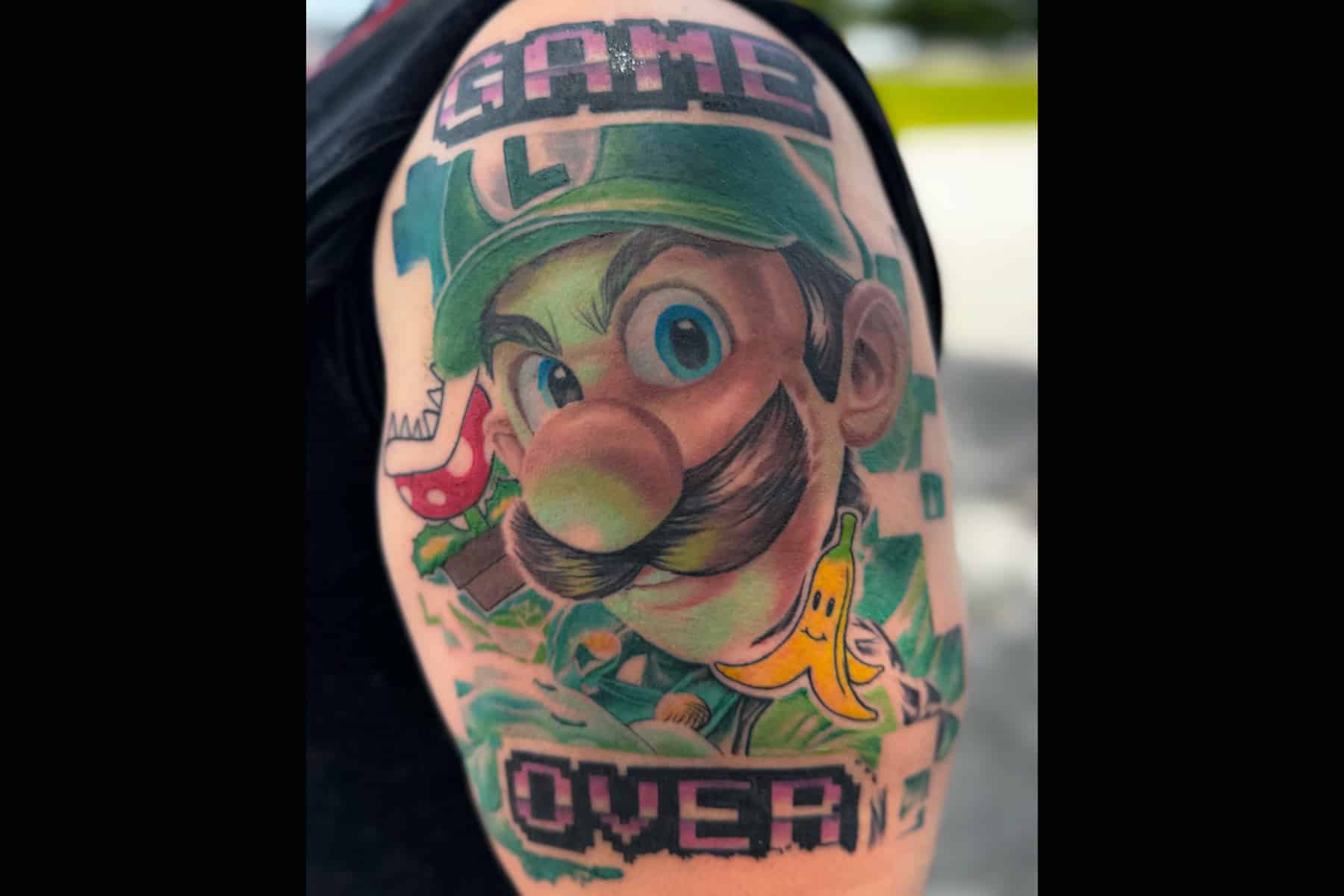Getting a piercing is exciting, whether you plan it or decide on the spot. But it comes with a responsibility: proper aftercare.
Piercing care can be different depending on where you live and what products are available. New products keep coming out, making it confusing. It’s best to talk to your local piercer for advice.
No matter your path, taking proper care of your new piercing is the key to successful healing! Whether you’re new to piercing or experienced, Good Vibrations Ink is here to give you clear and reliable information. We aim to help your piercing heal safely and look great.
What to Generally Expect After Getting a Piercing?
After getting a piercing, here’s what you can expect during the healing process. Initially, you might experience some bleeding, localized swelling, or tenderness. Bruising can occur after a piercing when excessive pressure is applied during the process, often resulting from the body piercer using overly tight clamps or applying too much force in the pierced area.
While some studios have been known to inadvertently cause bruising due to these factors, rest assured that our studio prioritizes careful and gentle techniques to minimize the risk of such issues during the piercing procedure.
As your piercing heals, you may notice some discoloration, itching, and the secretion of a whitish-yellow fluid, which isn’t pus but may form a crust on the jewelry. It’s also normal for the tissue around the piercing to tighten due to minor swelling.
Here are 5 things to be aware of after your piercing:
- Initial Stage: Shortly after getting your piercing, it’s normal to experience some of these symptoms. You may notice slight bleeding, localized swelling, tenderness, or bruising around the pierced area. Don’t worry! These are typical responses during the initial phase.
- During Healing: As your piercing starts to heal, you may observe mild discoloration, itching, and the discharge of a whitish-yellow fluid (not pus) that can form a crust on the jewelry. Additionally, the tissue around the piercing may tighten slightly due to minor swelling.
- Understanding Healing: It’s important to realize that a piercing may appear fully healed from the outside before the healing process is complete. Piercings heal from the outside in, so even if the exterior feels fine, the interior could still be delicate. Be patient and maintain proper cleaning and care throughout the healing period.
- Jewelry Considerations: During the healing process, it’s important to note that your jewelry should have some room for movement to accommodate potential swelling. The jewelry should move with ease. The jewelry’s ability to move more freely during healing accounts for any swelling that may occur. Avoid any attempts to force it to move, as certain pieces may fit snugly. If you prefer a looser fit, you can always consult your piercer about different jewelry sizes. We will delve deeper into jewelry considerations later on.
- Closure Risk: It’s essential to be aware that piercings, even long-standing ones, can close or shrink quickly, sometimes within minutes, depending on the individual. To prevent unexpected closure, ensure there is jewelry in your piercing at all times. We recommend paying special attention to the ball or bead. These should be tight on the threading to make sure the jewelry doesn’t fall out, but not add extra pressure on the piercing area.

What Not to Do After Getting a Piercing?
It’s equally important to know what to avoid as it is to understand the proper aftercare. This section will guide you through the products, activities, and personal habits you should steer clear of to ensure a successful healing process. From the type of skincare products to evade to the activities that may pose a risk, we’ll help you navigate the do’s and don’ts of piercing aftercare for a smooth and trouble-free experience.
Products to avoid with a new piercing
Cleaning Products
Avoiding certain cleaning products like alcohol, hydrogen peroxide, antibacterial soaps, iodine, and harsh cleaning agents is crucial after getting a body piercing because these substances can be detrimental to the delicate healing process. They can potentially harm the cells actively working to promote proper healing, thereby slowing down the recovery process and potentially causing complications.
For all piercings, we highly recommend incorporating sterile saline solutions into your cleansing routine. This step is one of the most important aspects of proper piercing care and maintenance.
Benzalkonium Chloride (BZK)
Steering clear of products containing Benzalkonium Chloride (BZK), such as Bactine® and ear care solutions, is essential because they can be irritating and aren’t designed for long-term wound care, potentially leading to discomfort and delayed healing. Opting for gentle, piercing-specific aftercare solutions ensures a safer and smoother healing journey for your piercing.
Beauty and Personal Care Products
Avoiding beauty and personal care products like cosmetics, lotions, and sprays near the piercing area is crucial because these products can introduce unwanted bacteria and chemicals to the healing piercing site, potentially leading to infections and irritation. The piercing is essentially an open wound during the healing process, making it vulnerable to contaminants.
Hanging Charms
Refraining from hanging charms or objects from your jewelry until the piercing heals fully is essential because such accessories can put undue stress and weight on the piercing, leading to discomfort, complications, and even potential damage to the healing tissue. Prioritizing a clean and uncomplicated healing environment is key to the successful and trouble-free healing of your new body piercing.
Activities to avoid with a new piercing
Over-Cleaning
Avoiding over-cleaning is essential after getting a body piercing because while maintaining cleanliness is crucial, excessive cleaning can hinder the healing process. Over-cleaning can disrupt the delicate balance of the body’s natural healing mechanisms, leading to extended healing times and potential irritation.
Trauma and Friction
Steer clear of activities that may cause trauma and friction to the healing piercing, such as excessive clothing pressure, frequent movement, playing with the jewelry, or vigorous cleaning. These actions can result in the development of scar tissue, migration of the jewelry, and prolonged healing, all of which can significantly impact the overall outcome of the piercing.
Avoid twisting your piercing as it can negatively impact the healing process. Excessive movement or rotation of the jewelry can introduce bacteria, cause unnecessary irritation, and slow down the natural healing of your piercing.
Submerging in Water
Avoid submerging the piercing in water because bodies of water like lakes, pools, oceans, and hot tubs can introduce harmful bacteria and contaminants to the healing site, potentially causing infections and complications. A temporary, waterproof, transparent film dressing is a precaution to safeguard your piercing, especially for certain types like nipple, navel, and surface piercings, ensuring a smoother and safer healing journey. You should remove this covering as soon as you are finished with your water activity – extended use will hinder the healing process and risks introducing bacteria into the healing area.
Personal activities and habits to avoid with a new piercing
Oral Contact and Bodily Fluids
Avoiding oral contact, sex, or contact with others’ bodily fluids near your piercing during the healing phase is crucial. These activities can introduce harmful bacteria and pathogens to the vulnerable piercing site, significantly increasing the risk of infections and complications. The healing tissue is delicate and sensitive, making it more susceptible to outside contaminants.
Unhealthy Habits
Steer clear of unhealthy habits like excessive stress, recreational drug use, high caffeine intake, nicotine, and alcohol during the healing process, as these factors can weaken the body’s natural immune response, slow down the healing process, and potentially lead to adverse reactions and prolonged recovery. Prioritizing a healthy and supportive lifestyle can greatly enhance the chances of a successful and trouble-free healing experience for your new body piercing.
Avoiding these practices will help ensure a smoother and safer healing process for your new piercing.
How do you take care of a new body piercing?
Now that you know what to avoid, let’s dive into the essential steps to maintain the cleanliness of your new body piercing and foster healthy healing practices.
What to Do:
- Begin by washing your hands thoroughly with soap and warm water for at least 20 seconds before touching your piercing. Minimize touching it, except when necessary for cleaning. However, it’s better to avoid touching it altogether.
- Avoid twisting, spinning, or rotating your jewelry during the healing process. Leave it in its initial position to avoid unnecessary trauma to the piercing.
- While exercising and sweating during the healing period is fine, avoid activities that could jostle or irritate the piercing, such as contact sports. Additionally, use a clean towel or barrier to shield your piercing from bacteria on gym equipment or exercise mats.
- Ensure you regularly wash and change your bedding, ideally every few days, to prevent bacteria buildup. Wear clean, loose-fitting, and breathable clothing that minimizes friction and protects your piercing while you sleep.
- Cleanliness is paramount. Open wounds are susceptible to bacteria, viruses, and fungi, so keeping your piercing free from contaminants is crucial for a successful healing process. Clean the area gently, as advised by your piercer, to avoid unnecessary irritation.
How to keep your piercing clean and promote healing
Let’s break down how to keep your piercing impeccably clean, step by step, to ensure a smooth and trouble-free healing process:
- Hand Hygiene: First and foremost, always wash your hands thoroughly with soap and warm water for at least 20 seconds before cleaning or touching your piercing. This might seem like a small detail, but its significance cannot be overstated. Dirty hands are like a welcome mat for germs and bacteria that can wreak havoc on your healing piercing. Starting with clean hands reduces the risk of infection and complications, giving your piercing the best chance to heal properly.
For all piercings, it is strongly advisable to include sterile saline solutions in your cleansing routine. This step is one of the most important aspects of proper piercing care and maintenance.

- Soap vs. Shower Gel or Bar Soap: When cleansing your piercing, we recommend using a specific type of soap, and not just any soap will do. We prefer non-colored, non-perfumed, anti-bacterial options like H2Ocean Blue-Green Foam Soap or AfterInked Foam Cleanser. These products are designed to be gentle while effectively cleaning your piercing. Avoid using harsh soaps or soaps with dyes or fragrances, as they can irritate your healing piercing.
- Proper Washing Technique: Here’s how to properly wash your piercing with the chosen soap:
- SOAP up: Gently lather the soap around the piercing, covering the entire area. This step helps remove any contaminants that may have accumulated.
- RINSE thoroughly: Rinse your piercing with clean, warm water to remove all traces of the soap. There’s no need to rotate the jewelry through the piercing; doing so can harm the healing process. If you find it convenient, you can invert a cup of warm water over the area to create a vacuum, making rinsing easier without needing a full shower.
- DRY gently: After cleansing, pat your piercing dry with clean, disposable paper products like gauze. Avoid using cloth towels and cotton swabs as they can harbor bacteria and potentially snag on your jewelry, causing injury. Proper drying helps prevent moisture buildup, which can lead to complications.
- Cleaning Solutions: Mixing your own sea salt solution used to be a common practice, but it’s no longer recommended by the APP (Association of Professional Piercers). DIY solutions often become too salty and strong, which can over-dry the piercing and interfere with healing.
Instead, we strongly advise using a sterile saline solution specifically labeled for wound care. Look for a product with .09% sodium chloride as the sole ingredient, with purified water occasionally listed. Avoid solutions with moisturizers, antibacterials, or similar additives, as they may hinder the healing process.
- Cleaning Instructions for Body Piercings: To clean your body piercing effectively, follow these steps:
- WASH your hands: Thoroughly wash your hands to ensure they’re clean before touching your piercing.
- SPRAY with sterile saline: While your piercing is healing, use a sterile saline wound wash to cleanse it. You don’t need to move or rotate the jewelry during cleaning – doing so might irritate the piercing. Feel free to clean up any drips but let the spray dry naturally.
- Sodium chloride products we recommend:
Following these cleaning steps will provide your new piercing with the best possible care, reducing the risk of complications and ensuring a safe and successful healing journey.
Body piercing jewelry
When it comes to body piercing jewelry, prioritize materials that are safe and suitable for your skin. Surgical stainless steel and titanium are the preferred choices due to their biocompatibility and strength. Titanium, being a higher-grade metal compared to implant-grade stainless steel, is known for its lighter weight and lower reactivity within the body, making it an excellent choice, especially for individuals with nickel sensitivities.
Titanium offers additional benefits such as
- non-magnetism,
- compatibility with airport scanners and MRIs,
- autoclave sterilization capability,
- corrosion-resistant,
- doesn’t react with bodily fluids,
- and can be anodized to alter its color appearance without compromising its safety.
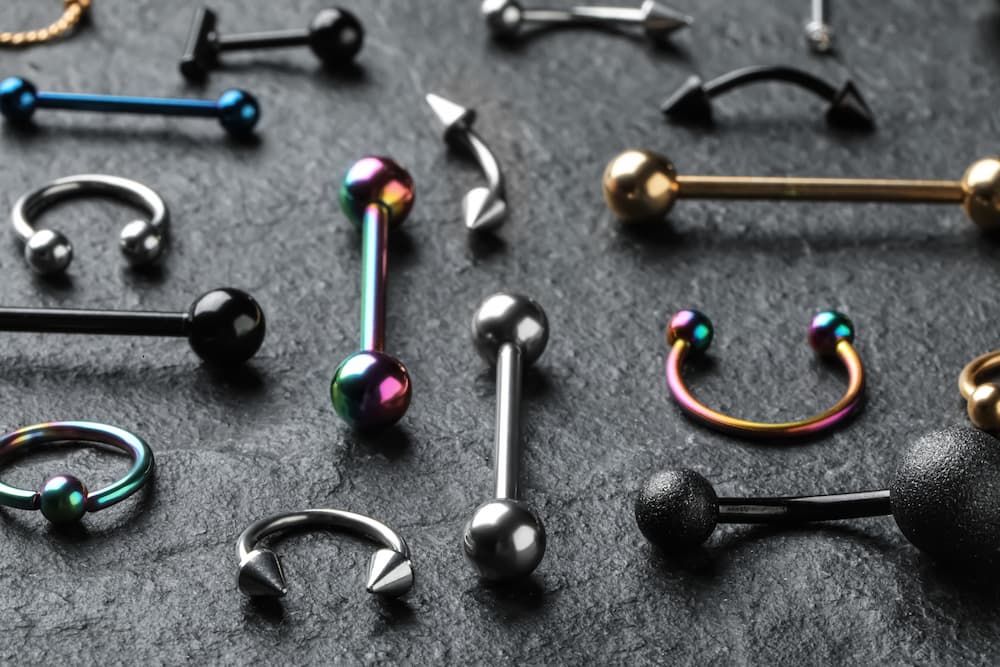
Good Vibration Ink provides anodized titanium jewelry, which involves a simple process of creating a thin oxide layer on the jewelry’s surface with electricity, resulting in various colors without the use of dyes or plating that could chip off within the body.
On the other hand, while surgical stainless steel is a common choice, it’s important to be sure that it is free of nickel, as nickel-containing jewelry is not suitable for piercings. Good Vibration Ink’s surgical stainless steel is nickel-free, but it’s essential to be cautious when purchasing jewelry online or from other sources without knowing the origin of the materials.
Low-quality jewelry can lead to issues like hypertrophic scarring (bumps), itchy skin, discharge buildup, and even piercing migration or rejection.
If you have a preference for gold jewelry, be aware that the majority of gold jewelry contains nickel. If you opt for a gold piercing, ensure that the jewelry is nickel-free, such as 24k gold, to prevent potential complications and reactions. At GVI, we prioritize your safety and offer threadless press-fit jewelry for your peace of mind and comfortable healing experience.
The choice of body piercing jewelry is a crucial factor in ensuring the successful healing of your piercing, and here’s why it matters:
- Consistency and Healing Stability: It’s essential to keep the initial jewelry in place throughout the healing period unless there’s a specific issue such as size, style, or material incompatibility. This consistency ensures that the healing process remains stable.
Changing jewelry too soon or using subpar alternatives can disrupt the healing process, potentially leading to complications such as irritation, prolonged healing, or even migration. Professional piercers are well-equipped to assess your jewelry needs and perform any necessary adjustments, ensuring that your piercing heals as smoothly as possible. - Preventing Premature Closure: Body piercings can close or shrink within minutes, even if they have been well-healed for a long time. Removing the jewelry, even temporarily, can make reinsertion difficult or impossible. To avoid this issue, it’s crucial to leave your jewelry in at all times, especially during the healing phase.
If you anticipate a situation where jewelry removal is necessary, such as a medical procedure, consult your piercer for non-metallic jewelry alternatives designed for short-term use. Keeping your jewelry in place guarantees that your piercing remains open and avoids the inconvenience of re-piercing. - Regular Jewelry Maintenance: Regularly checking and tightening your jewelry is essential to maintain the health of your piercings. Overly tight jewelry can lead to discomfort, irritation, and potentially even complications like migration. Use clean hands or paper products to ensure that threaded and threadless ends are securely fastened, you minimize the risk of problems arising during the healing period. Consistent maintenance contributes to a comfortable and hassle-free healing experience.
Stretching
Stretching body piercings are a fantastic way to customize your look, but they require careful consideration and proper aftercare.

The Why and When of Stretching
Stretching allows you to wear larger and more unique jewelry as your piercing size increases. It distributes weight and stress over a broader area, making it safe and comfortable to wear bigger jewelry.
However, there’s no universal timetable for stretching; it varies for each piercing and individual.
After moving up to a larger size, ensure your piercing fully heals and stabilizes before the next stretch, which can take weeks to months. Safe stretching demands both time and patience. Consult a professional piercer to determine if your piercing is ready for stretching.
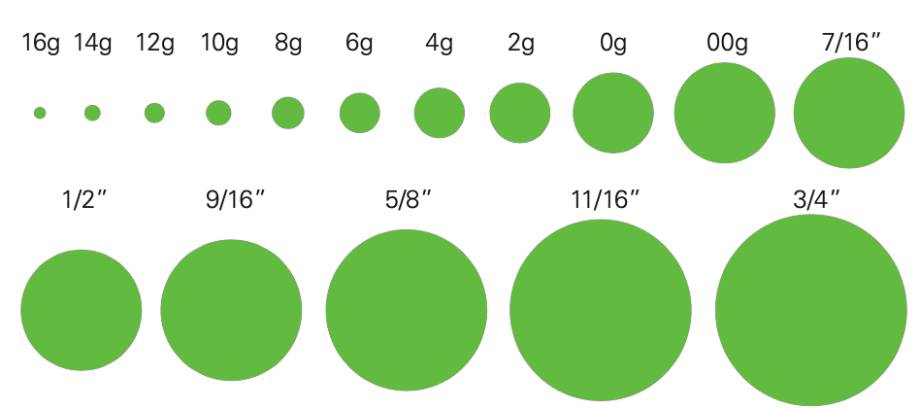
| Gauge | Inches | Millimeters |
| 20 | 1/64 | .8 |
| 18 | 1/32 | 1 |
| 16 | 3/64 | 1.2 |
| 14 | 1/16 | 1.6 |
| 12 | 5/64 | 2 |
| 10 | 3/32 | 2.5 |
| 8 | 1/8 | 3.2 |
| 6 | 5/32 | 4 |
| 4 | 3/16 | 5 |
| 2 | 1/4 | 6 |
| 0 | 5/16 | 8 |
| 00 | 3/8 | 10 |
| ** | 7/16 | 11 |
| ** | 1/2 | 12 |
| ** | 9/16 | 14 |
| ** | 5/8 | 16 |
| ** | 11/16 | 18 |
| ** | 3/4 | 19 |
| ** | 13/16 | 20 |
| ** | 7/8 | 22 |
| ** | 15/16 | 24 |
| ** | 1 | 25 |
Considerations for Permanent Change
Stretching a piercing isn’t the same as getting a new one. Before committing to this potentially permanent body modification, consider how large you want to go and whether your piercing can return to its prior appearance if you remove the jewelry. Overstretching or moving too quickly can lead to excessive scar tissue, limiting future stretching and preventing the piercing from returning to its original look.
Stretching Safely vs. Pain
If you choose to stretch your piercing yourself, it’s best to allow your initial jewelry to remain in place for an extended period. Never force jewelry in using pressure. Instead, wait until the piercing relaxes enough to easily accept the next size.
Stretching should not be excessively painful, but some discomfort may occur, especially with sensitive piercings. Severe pain, bleeding, or tearing is a sign of overstretching. Stop immediately if you experience discomfort, bleeding, or difficulty inserting the jewelry.
Seek a professional piercer’s assistance, especially for larger goals, is advisable. They can evaluate your piercing, recommend the right jewelry material and size, and perform the stretching safely. Misusing tools like insertion tapers can cause damage, so let a professional handle it.
Jewelry Choices
Use jewelry styles and materials approved for new piercings for initial stretches. Avoid acrylic, silicone, and organics until the area is fully healed. Solid plugs and hollow eyelets are popular styles, but be cautious with heavy jewelry, as it can lead to uneven stretching and tissue thinning. Do not use externally threaded jewelry or any with sharp edges for stretching.
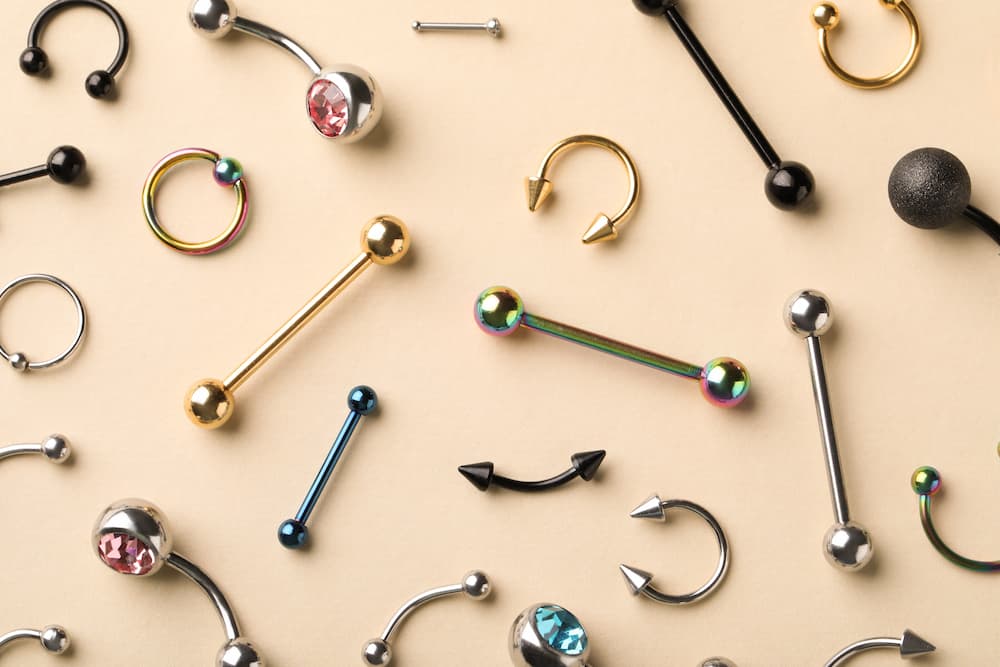
Massage and Moisturizing
Massage helps break down scar tissue and stimulate circulation. Use natural oils like jojoba or coconut to moisturize and prevent dryness, which can lead to brittleness and tears. Massage the tissue during your rest period (if applicable) to promote healthy, vibrant skin.
Aftercare and Long-Term Maintenance
After stretching, maintain good hygiene by leaving your new, larger jewelry in place for an extended time. Do not remove it too soon, as the piercing can shrink rapidly. Tenderness and inflammation are common initially, but they should subside in a few days.
Follow the aftercare advice for new piercings and wash or rinse your healed piercing in the shower as part of your daily routine. Occasionally remove the jewelry to clean both the tissue and jewelry thoroughly. Resting (especially for earlobes) by removing the jewelry for short intervals can relieve tissue stress and increase circulation.
Any soreness, redness, weeping, or inflammation may indicate a problem, like stretching too quickly or reacting negatively to jewelry. Treat the piercing as if it’s new, follow aftercare procedures, and consult your piercer if needed.
Downsizing (returning to your previous size) may be necessary to maintain tissue health. A blowout, common in earlobes, indicates an issue and should be addressed with the guidance of your piercer.
Remember, safe stretching requires patience and proper care. Take your time with the process, and always consult a professional piercer for guidance and assistance when needed.
FAQs for Specific Piercings
How long after a piercing can you shower?
You should shower the same day you get a piercing, but avoid soaking it directly. Use clean, warm water to rinse the area gently, and be cautious not to introduce excess moisture or harsh shower products.
Should I clean my piercing the day I get it?
Yes! It is recommended to clean your piercing on the day you get it. Follow the aftercare instructions provided by your piercer.
Should I rotate my piercing?
No, you should not rotate your piercing. Twisting or turning the jewelry can introduce bacteria, cause unnecessary irritation, and slow down the healing process. Instead, leave the jewelry in place and follow your piercer’s aftercare instructions for cleaning and care.
Ear/Ear Cartilage And Facial

How long until I can sleep on my lobe piercing?
Lobe piercings typically take about 6-8 weeks to heal enough for comfortable sleeping on them. However, it’s essential to listen to your body, and if you experience any discomfort or soreness, wait longer before sleeping on the pierced ear.
What is the t-shirt trick, and how can it help maintain a clean sleeping surface?
The t-shirt trick involves slipping a clean, large t-shirt over your pillow and placing your head on it while sleeping. By doing this, you create multiple clean surfaces for sleeping. You can rotate the pillow and turn the t-shirt inside out to access a fresh, clean area, helping to reduce the risk of introducing dirt, bacteria, or irritants to your healing piercing. This method ensures that you maintain a hygienic sleeping environment.
How often should I clean these items to prevent potential infections or complications?
To prevent potential infections or complications, regularly clean items like phones, headphones, eyeglasses, and other frequently used accessories. Aim for a daily or at least a weekly cleaning routine using an appropriate disinfectant. Items like hats, scarves, and headbands that come into contact with your piercing should also be washed regularly to maintain cleanliness and minimize the risk of irritation or infection.
Are there specific hairstyles or hair treatments I should avoid with a healing piercing?
During the healing process of a piercing, it’s advisable to avoid hairstyles and hair treatments that may put excessive stress or friction on the piercing site. Avoid tight hairstyles like high ponytails, braids, or cornrows that can pull on the jewelry. Additionally, be cautious with products and chemical treatments like leave-in conditioners, oils, hairspray, hair dye or perms, as they can irritate the piercing or affect its healing process. These products and treatments need to stay away from the piercing. Communicate with your hairstylist about your piercing to ensure they take necessary precautions during treatments and styling.
Why is it essential to avoid sleeping directly on a healing cartilage piercing?
Sleeping directly on a healing cartilage piercing can lead to irritation and even shifts in the piercing’s angle. To prevent this, consider using a travel pillow on top of your regular pillow and position your ear within the opening to minimize contact and discomfort.
Navel
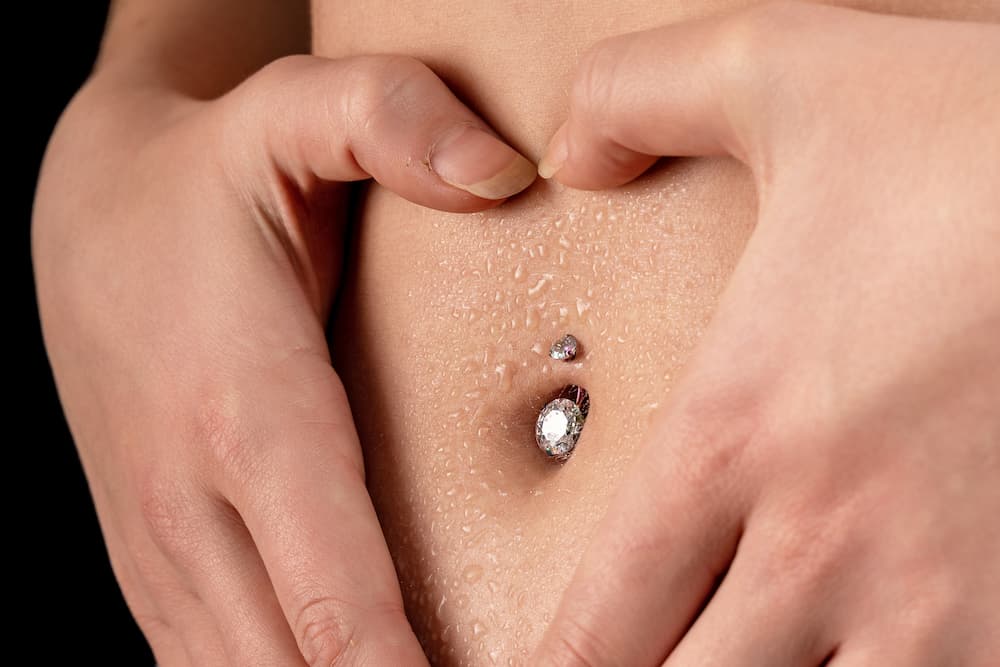
How should I clean my navel piercing to prevent infection?
To maintain the health and hygiene of your navel piercing and minimize the risk of infection, adhere to a strict cleaning regimen. Always begin by thoroughly washing your hands for at least 20 seconds with soap and warm water before handling or cleaning your piercing. Choose a gentle, anti-bacterial soap without dyes or fragrances, like H2Ocean Blue-Green Foam Soap, NeilMed Pharmaceuticals Piercing Aftercare Fine-mist, or AfterInked Foam Cleanser, and use it to carefully cleanse the piercing area. Afterward, rinse your piercing with clean, warm water, avoiding any unnecessary movement of the jewelry. To dry the piercing, gently pat it with disposable paper products, such as gauze.
Using products specifically formulated for piercing aftercare is essential because they are designed to be gentle, maintain the proper pH balance, and minimize irritation during the healing process. These specialized products also reduce the risk of infection and allergies, ensuring a safe and successful healing journey for your piercing.
For all piercings, we strongly recommend including sterile saline solutions as an important part of your cleansing routine. This step is one of the most important parts of caring for a piercing.
Can I swim or soak in water with a healing navel piercing?
It’s generally advisable to avoid swimming in pools, hot tubs, or natural bodies of water like lakes or oceans during the initial healing period of your navel piercing, which can take several months. These environments can introduce bacteria and irritants to the piercing site, increasing the risk of infection or complications. Once your piercing fully heals, you can enjoy swimming, but always ensure you clean the area thoroughly afterward.
Can I change my navel jewelry during the healing process?
We recommend keeping your initial jewelry in place until your navel piercing has completely healed, which can take several months. Changing the jewelry prematurely can disrupt the healing process and potentially introduce bacteria to the piercing site. Consult with a professional piercer if you want to change your jewelry after the healing period to ensure it’s done safely and with appropriate jewelry options.
How long should I avoid tight clothing or waistbands that might rub against my navel piercing?
It’s advisable to avoid tight clothing and waistbands that can rub against your navel piercing for the entire healing period, which typically takes around 6 to 9 months. Friction from clothing can irritate the piercing, delay healing, and potentially lead to complications. Opt for loose-fitting clothing or consider using a temporary padded bandage (no longer than a few hours) or a sterile non-stick dressing as a protective barrier until your piercing is fully healed.
Nipples
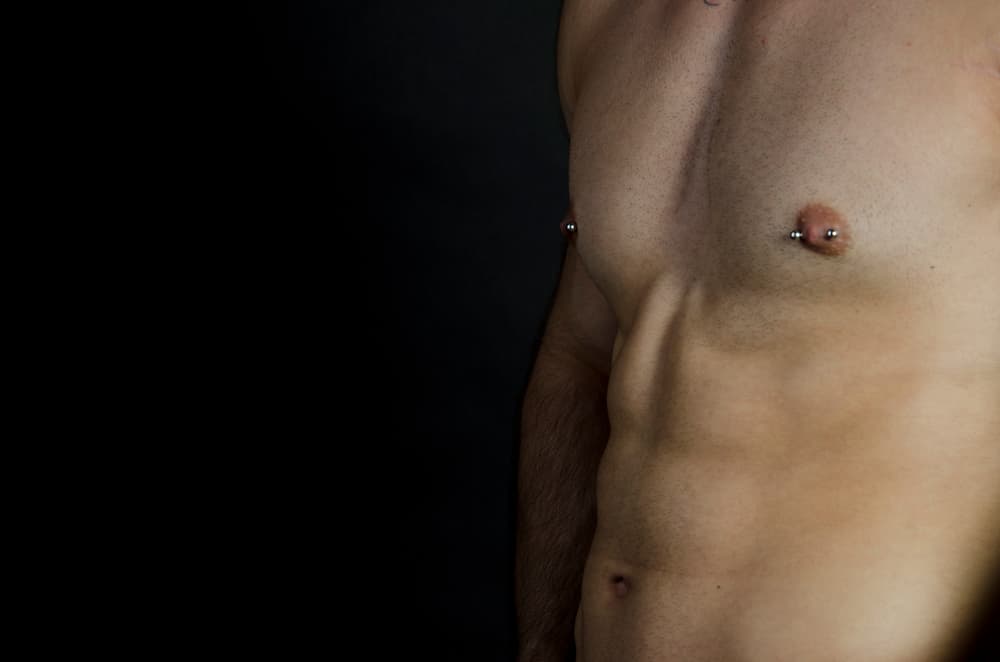
Can I use regular soap to clean my nipple piercings?
No, it’s best to AVOID using regular soap on your nipple piercings, as it can be too harsh and may disrupt the healing process. Using specialized piercing aftercare products is recommended for their gentle formulation, proper pH balance, and reduced risk of irritation, infection, and allergies during the healing process, ensuring a safe and successful piercing journey. Opt for a gentle, antibacterial soap without dyes or fragrances, like H2Ocean Blue-Green Foam Soap, NeilMed Pharmaceuticals Piercing Aftercare Fine-mist, or AfterInked Foam Cleanser, and use it to carefully cleanse the piercing area. Rinse your piercings with clean, warm water, avoiding unnecessary jewelry movement, and gently pat them dry with disposable paper products, such as gauze.
Include sterile saline solutions in your cleaning routine, as this is one of the utmost critical elements in proper piercing care and maintenance.
Is it safe to engage in sexual activities while my nipple piercings are healing?
Engaging in sexual activities is generally safe with nipple piercings, but you should take precautions to avoid any trauma or irritation to the piercings. Be mindful of your partner’s actions to prevent accidental tugging or pulling on the jewelry. It’s advisable to wait until your nipple piercings are fully healed, which can take about 6 to 9 months, before participating in more intense or rough activities.
How can I protect my nipple piercings during physical activities or contact sports?
To protect your nipple piercings during physical activities or contact sports, consider wearing a sports bra with extra padding or using padded nipple covers to reduce friction and minimize the risk of injury. Ensure that your piercing jewelry is snug and secure to prevent accidental dislodging during movement. It’s essential to follow proper aftercare and maintain good hygiene to minimize the risk of complications while engaging in physical activities.
Oral
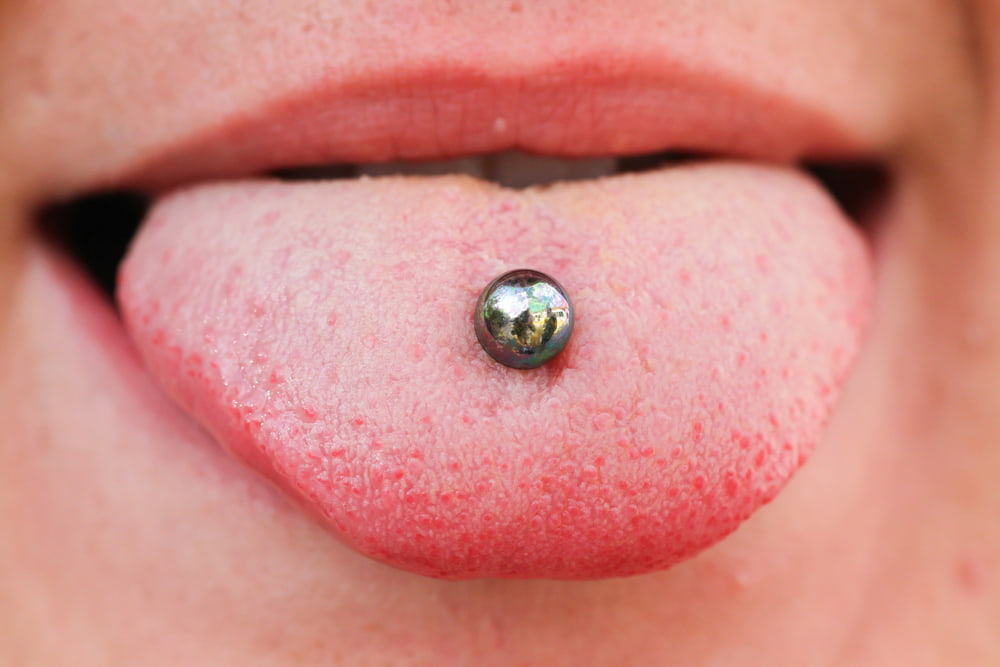
Taking care of oral piercings requires special attention to ensure proper healing and maintain your overall oral health. Here are detailed tips and insights to help you through this process:
Appropriate Cleaning Solutions: It’s crucial to use the right solutions for oral piercings. Opt for alcohol-free and hydrogen peroxide-free mouth rinse, dry mouth oral rinse for hydration, plain clean water, or packaged sterile saline solution without additives. These choices help maintain a clean environment for your piercing while minimizing irritation. Avoid using contact solution, eye drops, or nasal rinse products, as they are not suitable for oral piercings.
Internal and External Cleaning: Proper hygiene practices are essential for oral piercings. For internal cleaning, ensure you floss, brush, and use mouth rinse at least twice a day without overusing the rinse. Gently brush the jewelry with a clean toothbrush to prevent plaque buildup. Rinse thoroughly with water (bottled or filtered) after eating, drinking, or smoking. For external cleaning, rinse your piercing with warm water during your daily shower and follow up with saline rinses twice a day. Gently remove any discharge or crust that may have formed on your jewelry and carefully dry the area with gauze.
Normal Healing Process: Understand what to expect during the healing process. Initially, you may experience swelling, light bleeding, tenderness, bruising, and whitish to yellowish secretions that can form crust on the jewelry. Even after the first week, some minor swelling and secretion may persist. It’s essential to realize that a piercing may seem healed on the outside before the internal healing is complete, as piercings heal from the outside in. Therefore, continue cleaning diligently throughout the entire healing period.
Jewelry Maintenance: Maintain your oral piercing jewelry to prevent complications. Ensure that threaded and threadless ends are securely fastened with clean hands or paper products to avoid discomfort and irritation. Regular jewelry checks are vital for your piercing’s health. If you anticipate a situation where jewelry removal is necessary, such as a medical procedure, consult your piercer for non-metallic jewelry alternatives designed for short-term use. In case you decide to remove the piercing, continue cleaning the area until the hole closes, leaving only a small mark.
Oral Hygiene and Healthy Lifestyle: Good oral hygiene is crucial during the healing process. Use a new soft-bristled toothbrush and practice daily flossing and gentle brushing of your teeth, tongue, and jewelry. As your piercing heals, brush the jewelry more thoroughly to prevent plaque buildup. A healthy lifestyle that includes sufficient sleep, a nutritious diet, and stress management will bolster your healing abilities and reduce the risk of complications. Additionally, avoid smoking, chewing tobacco, or excessive caffeine intake during healing, as they can prolong the recovery process.
Why you should avoid alcohol with a new oral piercing: When it comes to oral piercing aftercare, avoid alcohol consumption, particularly beer, as the yeast can lead to excessive swelling. Alcohol can interfere with the healing process and increase the risk of complications. Swelling is a common issue during the initial stages of oral piercing healing, and consuming alcohol can intensify this problem.
For oral piercings, we recommend avoiding alcohol for a minimum of two weeks after getting the piercing. After this initial period, if you choose to consume alcohol, it’s essential to do so in moderation. Additionally, remember to rinse your mouth thoroughly after alcohol consumption to minimize any potential risks to your healing oral piercing.
Swelling Management: To reduce swelling, consider allowing small pieces of ice to dissolve in your mouth and taking over-the-counter, non-steroidal anti-inflammatory drugs like ibuprofen or naproxen sodium as directed. Minimize excessive movement or speaking to help reduce swelling, and sleep with your head elevated above your heart during the initial nights.
Food and Beverage Choices: Be cautious with your food and beverage choices, especially in the initial stages. Avoid spicy, salty, acidic, or hot-temperature foods and beverages for the first two weeks, as they can irritate the piercing. Opt for cold foods and beverages to soothe swelling. For specific piercings like labret (cheek and lip), be mindful of not opening your mouth too wide to prevent the jewelry from catching on your teeth.
WHAT TO AVOID
- Avoid playing with your jewelry to prevent permanent damage to your teeth and gums.
- Steer clear of undue trauma, such as excessive talking or playing with the jewelry, as it can lead to scar tissue, migration, and complications.
- Alcohol or hydrogen peroxide-containing mouthwash should be avoided, as they can irritate the piercing.
- Avoid any oral sexual contact, including wet kissing or oral sex, during the healing process.
- Refrain from chewing on tobacco, gum, fingernails, pencils, sunglasses, or other foreign objects that may harbor bacteria.
- Do not share plates, cups, or eating utensils and avoid using straws, which can increase swelling and bleeding.
- Minimize smoking and vaping, whether tobacco or cannabis, as they increase risks and prolong healing time.
- Additionally, steer clear of aspirin, alcohol, and excessive caffeine intake while experiencing bleeding or swelling.
- Avoid submerging your healing piercing in bodies of water, such as lakes, pools, oceans, or bathtubs.
Remember that healing times can vary significantly from person to person, so don’t hesitate to contact a professional piercer if you have any questions or concerns about your oral piercing’s care and progress.
Make an Impact with Your Body Piercing Art at Good Vibrations Ink
Piercings are a fun and unique way to define yourself without being as permanent as a tattoo. With all that being said, getting a piercing is a great experience, whether it’s your 1st or your 10th! Aftercare plays a huge part in the aftermath of your piercing’s health.
At Good Vibrations Ink we highly encourage our customers and clients to really understand the meaning of good aftercare. We want your piercings to stay beautiful for as long as possible, which means being aware of the instructions we just discussed.
Body piercing is a form of art. Don’t be careless! Follow our aftercare instructions for the best results. You can always contact our tattoo studio with any questions you may have. Thanks for reading, and enjoy your new piercing!


